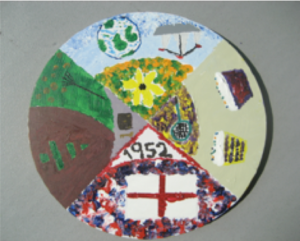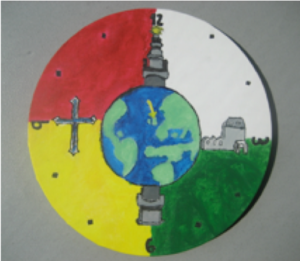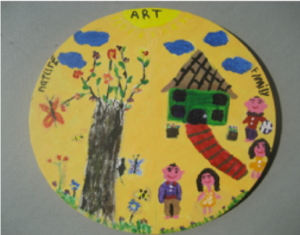An investigation into questions about life, suffering and death, using Buddhist sand mandala, shrines and through contact with a local hospice.
For Upper KS2. Originally written by Sabah Raza, updated in April 2019.
Key words
Mandala: The meaning of mandala comes from Sanskrit meaning ‘circle’. The circle represents a symbolic picture of the universe in Buddhism and Hinduism, often using geometric patterns.
Sand Mandalas: An ancient, sacred form of Tibetan Buddhist art. According to Buddhist scripture, mandalas made from sand transmit positive energies to the environment and to the people who view them; they are believed to purify and heal. The Buddha himself introduced mandala sand painting; the many different sand designs each have a different lesson to teach.
Sacred Tibetan Mandala: The mandala’s purpose is to help transform ordinary minds into enlightened ones and to assist with healing.
Chak-pur: Cone shaped metal funnels with ridges, used to disperse sand in a controlled way.
Buddha: The Buddha was born as Siddhartha Gautama in Nepal around 2,500 years Siddhartha was born into the royal family of a small kingdom on the Indian- Nepalese border. He is believed by Buddhists to be a human being who became Enlightened (awakened).
Buddhism: Buddhism is a religion to about 300 million people around the world. The word comes from ‘budhi’, ‘to awaken’. It has its origins about 2,500 years ago. The basic concepts in Buddhism can be summed up by the Four Noble Truths and the Noble Eightfold Path.
Dalai Lama: The 14th Dalai Lama, Tenzin Gyatso, is believed by his followers to be the spiritual leader of Tibet and the Head Monk of Tibetan Buddhism.
Monk: A member of a religious community of men, typically living under vows of poverty, chastity, and obedience.
Nirvana: the highest state that someone can attain, a state of enlightenment, meaning a person’s individual desires and suffering go away; the goal of the Buddhist path.
Life: The condition that distinguishes animals and plants from inorganic matter, including the capacity for growth, reproduction, functional activity, and continual change preceding death.
Dying: Occurring at or connected with the time that someone dies.
Death: The action or fact of dying or being killed; the end of the life of a person or organism.
Hospice: a home providing care for people with a life limiting illness.
Note
If possible, this lesson involves some children visiting a local hospice to create a mandala with residents.
An alternative could be a visit to the classroom of staff form the hospice, or pupils interview family members.
Learning activities
You will need to find the following items online:
- Still image of Buddhists constructing a sand mandala
- Video of the construction and destruction of a sand mandala
- Information about a hospice- website or video
Begin by displaying any image of Buddhists constructing a sand mandala, there are many online, including of the Dalai Lama.
On each table, have an A3 copy of the image stuck on a large piece of sugar paper (groups of six work well for this activity)
Ask the pupils to write down one question each about what they would like to find out about the picture and stick it around the picture [small sticky notes work best].
Ask them, in their groups, to select one question, putting the rest of the questions to one side for now. [Help pupils to modify the question if necessary, so that the question is an ‘open’ one with no ‘easy answer’.]
Encourage one pupil from each group to read out their chosen question, then ask the class to select one main question, which will be investigated over the course of the topic.
The rest of the questions can go in to a ‘We Were Wondering…’ box, to be answered by pupils as extension work over the duration of the unit.
Now show the class the video clip of the construction and destruction of a sand mandala, asking them to look out for answers to some of the questions they might have heard earlier and to note down anything they think is important.
Ask the pupils:
- to feedback any key points they picked up and/or to answer any of the questions that were asked on their table
- What did you notice was being made in the video?
- What do you think the meaning of the image is?
- What sounds, sights and actions did you notice?
- What people did you notice?
- What happened to the image?
- What do you think happens to the sand?
Explain that Buddhists (who follow Buddhism) believe in a cycle of life, death and rebirth. Nirvana is believed to be the end of the cycle of death and rebirth and that Buddhism teaches that Nirvana is reached when all want and suffering is gone. Explain that Nirvana Day is an annual Buddhist festival that remembers the death of the Buddha (the founder of Buddhism) when he passed into Nirvana at the age of 80. On Nirvana Day, Buddhists think about their lives and how they can work towards gaining the perfect peace of Nirvana. They remember friends or relations who have recently died and reflect on the fact that death is a part of life for everyone.
Explain that the idea that nothing stays the same is central to Buddhism. Buddhists believe that loss and change are things to be accepted rather than causes of sadness. Mandalas are a key symbol for this idea, a circle that carries on and on. Sand mandalas that are constructed and deconstructed illustrate this especially well. Explain that this idea is key to their learning in this unit.
Ask the question, What happens to us after we die? What do you think? [Have it written on a large piece of sugar paper.] Encourage pupils to write a brief response on a sticky note and stick it around the question on sugar paper. Give them an opportunity to discuss their answer to this, first in pairs, then as a group and then as a class. Over the course of the next few lessons, read out a few ideas about what pupils think happens to us after we die. Some pupils may suggest viewpoints from their faith, which could lead to further discussions. Have a selection of books from all faiths available and if possible, a pupil laptop for further investigation.
Ask the pupils to think about something or someone they have lost. How did it make them feel? Give out thought bubbles. Ask them to write down their thoughts and feelings and give them an opportunity to share their feelings if they wish to do so.
As a whole class, create a Buddhist Shrine with the following artefacts: a statue of Buddha (Buddharupa), incense (symbolising the fragrance of the perfect life), flowers (the impermanence of life) and lights or candles (representing truth). [Over the coming weeks, the pupils should see the flowers withering and die, demonstrating and reinforcing the key message that loss and change are to be accepted and that all living things die. It is best not to use carnations or chrysanthemums because these remain fresh for a long time. Refer back to the shrine weekly, making observations of the flowers. Add the main class enquiry question to this display, referring back to it at the beginning of each lesson. Have the box of remaining class questions nearby on display, with books on Buddhism for reference.]
Encourage pupils to describe the different items in the shrine and how they reflect Buddhist beliefs.
Introduce pupils to the word ‘Hospice’ and ask Does anyone know what a hospice is or who might go visit one? Think about the beginning part of the word ‘hosp’, does it remind you of anything? What kind of a building do you think it is? What would you expect to find inside? Ask the pupils to write their ideas on a large sheet of paper, to compare to attitudes later in the lesson.
Explain what a hospice is and who would use it. [A home/place that provides care for people with a life limiting illness.] Show information you have researched about a hospice.
Ask for pupils’ responses to such questions as: What do you think about hospices now? Has your opinion changed? What kind of place do we now know a hospice is? How helpful is it to the people that visit it/stay there? Tell me about the sort of people that work/volunteer there. What kind of things can people do there? Ask pupils to compare responses to answers written down earlier.
Ask pupils to suggest similarities and differences they can identity between what they notice about the hospice and Buddhist beliefs, attitudes and symbols. [Bring out points about life, suffering and death and the feelings associated, e.g., with items in the Buddhist shrine, like candles, or in the making of sand mandalas, such as peacefulness, emotional needs, acceptance of change and death.] Ask them to suggest reasons for similarities and differences and whether they think having religious beliefs might make a difference to a person’s attitudes to hospices.
If you are making a hospice visit
Explain that some of the class will be visiting a hospice and will be working with a patient (in pairs), to create a beautiful mandala with oil paints.
Use cardboard or canvas to paint on.
Explain that when they visit, they will be able to talk to their patient and ask prepared questions, so they can start to depict that patient’s life story on a mandala. Remind pupils that the patients they will be meeting will have a life limiting illness and that this is their opportunity to leave a legacy at the hospice/school of their life journey in the visual art form of a Buddhist Mandala. To help pupils make the explicit link, remind them at this point of the Buddhist belief that loss and change are things to be accepted rather than causes of sadness and that Mandalas are a key symbol for this idea.
Alternatively, staff from the hospice can be invited in to lead this session to meet the pupils and answer questions.
Or
Children can interview family members.
Most hospices will only be able to accommodate a fixed number of pupils, depending on space and the number of patients using their services at that time. One suggestion is to select pupils on your gifted and talented register for RE and Art. The rest of the pupils complete the same activities, however they prepare a mandala to tell the story of a parent/grandparent/carer and complete this in school.
Note: Pupils interviewing family members will need to be reminded that they should not ask questions about an illness, e.g. What have you been diagnosed with? Their focus should be the life journey of that person, e.g. key events/journeys/moments in their lives. When selected pupils are visiting the hospice over the next three weeks (for one morning or an afternoon, to be agreed with the Hospice), the rest of the class/classes remain in school to prepare their mandalas.
After a tour of the hospice to view their facilities, pupils ask their questions to their patients. It is key that this is in a relaxed environment and is informal, if possible over a glass of squash and biscuits! Pupils in school will have taken their questions home as homework and should have had their discussions already. All pupils should begin to think about symbols, words or pictures to represent key events and the general layout of the mandalas in this session.
Ask all the pupils, over the next two or three sessions, to draw, then paint their mandalas, either in class, or jointly with their patient at the hospice. Encourage them to use different forms of expression, e.g., words as well as symbols, and to describe the meaning(s) of their designs. [As the project progresses, pupils will have begun to develop confidence and important conversations may be taking place between the patient and the pupils. This spiritual, moral and social element of the project is absolutely key here.]
It may be appropriate to also hold a small ‘tea party’ at the hospice, to include any patients that may be too unwell to travel to school for the assembly. The parents of the pupils involved could also be invited to this. One of the aims is to raise awareness of the great work of hospices and to encourage parents to donate and/or support the school in fundraising for your local hospice.
Encourage pupils to think of five questions to ask a partner in class. Encourage them to think carefully about the wording of their questions and explain that they should try to find out as much as possible about that person, including their beliefs about what they think happens after death, whilst being tactful. Give pupils an opportunity to feedback what they have found out about their friend. Highlight good examples of open questions and suggest ways of rewording closed questions.
Ask them then to compile a similar list of questions to ask their patient or family member; all pupils could use this question as a starting point: Buddhists believe that loss and change are things to be accepted rather than causes of sadness. We will be painting mandalas, as they are a symbol of this idea, a circle that carries on and on. What do you believe happens after we die? Encourage them to suggest answers that might be given by the patients. Ask them to say what answers they think might be given by a patient who was a Buddhist.
Refer pupils back to the Buddhist Shrine and the main class question on life, death and dying and ask them what they have learnt. Invite answers to the main question. Observe the flowers (they should be at least wilting by now, if not dead), demonstrating and reinforcing the key message in Buddhism, that loss and change are to be accepted and that all living things die.
In the final week, hold a whole school assembly, to which all of the year group’s parents are invited, along with the patients and staff of the hospice. This should be a celebration of the completed mandalas. Where possible, pupils and patients briefly present their life journeys and talk through the words and symbols on their mandala, highlighting reasons for similarities and differences in the forms of expressing meaning, and the questions and answers about life, suffering and death that they explored. Pupils who represented the lives of family members on their mandalas, should also showcase their work in this assembly with their family member if possible.
Here are some examples of complete mandalas:



We recommend extending the unit with the activities below:
Divide pupils in to groups of six. Each group chooses a religion or philosophy of life represented in the UK and prepares a project to show adherents’ beliefs about life and death. Pupils plan their own enquiry and resources they will need, asking ‘What do they believe about life and death?’
Note: ensure you are using a pupil-friendly search engine, as there are many inappropriate websites and video clips on death. We recommend setting up several ‘fixed’ searches in a folder of safe websites, that pupils can select from.
Use Mackley, J. (2006) Exploring the Journey of Life and Death, Birmingham: RE Today Services. This publication has several challenging activities, encouraging children to think about the journey of life and death. For example, pupils could explore their own ‘journey of life’ by thinking about the high points and low points in their life so far. Pupils could also explore ‘The Journey of Life’ illustration and pick a route they would like to take, thinking about what they would avoid and what they would include and pupils could write the first page of a ‘Guidebook’ for life.


